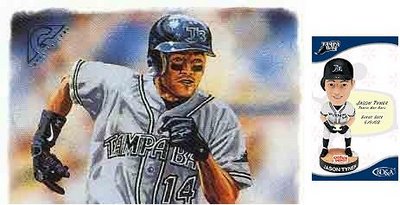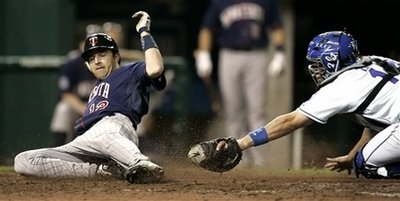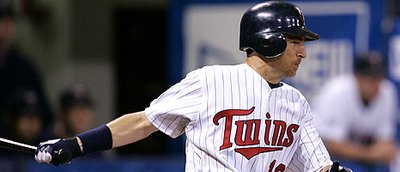June 12, 2007
The Jason Tyner Story
Tyner was pushed very aggressively right away, reporting directly to high Single-A after signing and hitting .303/.361/.343 in 50 games. He jumped up to Double-A in 1999, batting .313/.387/.369 in 129 games, and then hit .321/.380/.349 in 84 games at Triple-A in 2000. Tyner made his major-league debut on June 5, 2000, leading off the game with a single against Mike Mussina. He remained with the Mets for the rest of the month and struggled, going just 6-for-38 (.158) following a two-hit debut.
On June 28, the Mets traded Tyner and fellow former first-round pick Paul Wilson to the Devil Rays in exchange for Bubba Trammell and Rick White. Given his size, skill set, and college numbers, Tyner's performance during his first three pro seasons was almost exactly what the Mets should have expected. Whether or not that was actually the case, the Mets sent him packing after a rough first three weeks in the majors, almost exactly two years after using a first-round pick on him.
Tyner finished the season by hitting .241/.281/.265 in 37 games with the Devil Rays and began the next year back at Triple-A. After hitting his usual .312/.371/.338 in 39 games there to begin the 2001 season, the Devil Rays called him back up in late May and Tyner played in 105 of the team's final 122 games. Alternating between center field and left field while primarily leading off for a team that went 62-100 in its fourth year of existence, Tyner batted .280/.311/.326 with 31 steals in 420 plate appearances.
While far from good, that performance apparently made the Devil Rays view a 24-year-old Tyner as a long-term building block, because they scheduled "Jason Tyner Bobblehead Day" for the next season. Unfortunately, Tyner hit just .214 through the team's first 45 games and was sent back to Triple-A at the end of May, before the bobbleheads could be given away. Tyner returned to Durham and posted his usual .291/.362/.348 hitting line in 88 games, but remained in the minors for the rest of the season.
 After a poor spring, Tyner began the 2003 season back at Durham. He was called back up in mid-May and remained in the majors for about a month, hitting .290/.355/.391 in 78 plate appearances. Those numbers were by far the best of Tyner's career and essentially represented the best-case scenario based on his extensive minor-league track record. Despite that, the Devil Rays demoted him to Triple-A again in early June and then gave him sporadic playing time following a recall in mid-August.
After a poor spring, Tyner began the 2003 season back at Durham. He was called back up in mid-May and remained in the majors for about a month, hitting .290/.355/.391 in 78 plate appearances. Those numbers were by far the best of Tyner's career and essentially represented the best-case scenario based on his extensive minor-league track record. Despite that, the Devil Rays demoted him to Triple-A again in early June and then gave him sporadic playing time following a recall in mid-August.
Now 25 years old and with parts of four big-league seasons under his belt, Tyner had gone from one of the Devil Rays' "stars" to being completely absent from their plans within the span of about 18 months and 250 at-bats. Placed on waivers shortly after the 2003 season, Tyner was claimed by the Rangers, who released him the next spring. He signed a minor-league contract with the Braves for 2004 and reported to Triple-A, but was released in late July after hitting .288/.346/.358 in 64 games.
Tyner latched on with the Indians about a week later and finished the season strong with their Triple-A team, hitting .345 in 38 games. That performance failed to earn him a September call up to Cleveland and Tyner signed a minor-league deal with the Twins following the season. Tyner spent the 2005 season at Rochester, batting .286/.351/.334 in 133 games. Unlike with the Indians, that earned him a call-up once rosters expanded in September and Tyner hit .321/.367/.375 in 60 plate appearances.
Satisfied by his experience with the Twins or simply tired of bouncing from one organization to another, Tyner re-signed following the season and reported back to Triple-A in 2006. He hit .329/.379/.405 in 80 games at Rochester, posting the best numbers of his career aside from that 38-game stint at Triple-A Buffalo in 2004. That earned him a trip back to Minnesota in mid-July and this time Tyner worked his way into significant playing time.
 Stepping in as the starting center fielder with Torii Hunter sidelined and then taking over for the injured Shannon Stewart as the starting left fielder once Hunter returned, Tyner batted .312/.345/.353 in 232 plate appearances. Tyner started 58 of the team's final 75 games and saw the second-most playing time of his career behind only that bobblehead-inducing 2001 season with the Devil Rays. Improbably, he also started at designated hitter in two of the three playoff games against the A's.
Stepping in as the starting center fielder with Torii Hunter sidelined and then taking over for the injured Shannon Stewart as the starting left fielder once Hunter returned, Tyner batted .312/.345/.353 in 232 plate appearances. Tyner started 58 of the team's final 75 games and saw the second-most playing time of his career behind only that bobblehead-inducing 2001 season with the Devil Rays. Improbably, he also started at designated hitter in two of the three playoff games against the A's.
Now 30 years old, Tyner headed to spring training in Fort Myers this March as part of the team's plans and left camp with a big-league roster spot for the first time since 2002. Initially slated to serve as the Twins' fourth outfielder, Tyner found himself in the starting lineup by Game 3 and started 24 of the team's first 60 games (including 10 starts at DH). After a strong start, Tyner cooled off considerably and has hit .264/.313/.321 in 116 plate appearances.
In parts of the three seasons with the Twins, Tyner has hit .300/.339/.347 in 408 plate appearances. Take a look at how that performance compares to what he did with the Devil Rays (and Mets):
TEAM PA AVG OBP SLG BB% SO% IsoP
Tampa Bay 844 .257 .294 .299 4.4 10.5 .042
Minnesota 408 .300 .339 .347 4.4 7.4 .047
While in Tampa Bay, Tyner seemingly focused on using his speed once he was on the bases, rather than actually working to get on base at a solid rate. That produced 46 steals in 844 plate appearances, but more importantly he made an out over 70 percent of the time he stepped to the plate. Whether you choose to look at it as "since being let go by the Devil Rays" or "since joining the Twins," Tyner has shifted his concentration from running while on the bases to getting on base to begin with.
Prior to 2005, Tyner attempted a stolen base for every 4.3 times he reached base. Since then, he's attempted a stolen base for every 11.5 times he reached base. Some of that is due to age slowing him down, but it's also because the Tyner-era Devil Rays simply equated "leadoff man" with "running fast." While not running nearly as much, what Tyner has been able to do with the Twins is actually more valuable for a player with his skill set.
Tyner's plate discipline and power have essentially remained non-existent in Minnesota, but the one significant change in his game is making far more contact. Prior to 2005, Tyner struck out in 10.5 percent of his plate appearances, but since then he's dropped that to 7.4 percent. That may not seem like much, but it's big for a player whose hits are almost all slapped through holes, blooped in front of outfielders, bunted, or chopped in places where he can beat the throw to first base.
The idea that making better contact and putting more balls in play leads to more hits is basically true for all hitters, but for someone like Tyner it's even more important than usual. He has yet to hit a homer in 1,252 career plate appearances, which is the longest homerless drought among active players and the third-longest in all of baseball over the past 50 years. Toss in just 33 doubles and nine triples over that span and 87 percent of Tyner's hits have ended with him standing on first base.
Because of that, it's no coincidence that since 2005 Tyner's batting average has risen 17 percent while his strikeouts have dropped 30 percent. For many hitters, cutting down on strikeouts would also mean cutting down on power, which might actually hurt their batting average and overall production. However, with Tyner the ball isn't going far anyway, so the equation is simple: If he puts more balls in play, he'll be standing safely on first base more often.
Even with an improved approach at the plate, Tyner's complete lack of secondary skills make him one of the rare hitters who can avoid having significant value even when batting .300. Despite a .271 career batting average (including an even .300 with the Twins), Tyner's OPS is just .624. When compared to the league average, that ranks as the second-worst OPS of any outfielder with at least 1,250 plate appearances in the past 50 years:
PLAYER LEAGUE DIFF
Peter Bergeron .612 .786 -.175
JASON TYNER .624 .765 -.141
Doug Dascenzo .590 .715 -.125
David Hulse .644 .763 -.120
Darren Lewis .645 .764 -.116
Eric Owens .664 .780 -.116
Brian Hunter .660 .773 -.113
Adrian Brown .666 .779 -.113
Chuck Carr .649 .760 -.112
Milt Cuyler .631 .739 -.109
What's amazing is that Tyner's .271 batting average is the highest of anyone on the above list and four of the other nine hitters batted .250 or worse (including Peter Bergeron at .226). In other words, not only is he incredibly unproductive, Tyner is the epitome of an "empty batting average." Tyner hasn't lost much speed yet and possesses just enough range defensively to be passable in center field, which makes him at best a "textbook" fifth outfielder.
 Unfortunately, he's been stretched into a much bigger role since joining the Twins. Hunter's presence in center field, the Twins' lack of offensive depth, and Ron Gardenhire's infatuation with banjo-hitting speedsters have led to Tyner starting regularly at DH and spending most of his outfield time in left field. Not only does that negate whatever limited value he potentially brings to a team, it highlights his considerable weaknesses.
Unfortunately, he's been stretched into a much bigger role since joining the Twins. Hunter's presence in center field, the Twins' lack of offensive depth, and Ron Gardenhire's infatuation with banjo-hitting speedsters have led to Tyner starting regularly at DH and spending most of his outfield time in left field. Not only does that negate whatever limited value he potentially brings to a team, it highlights his considerable weaknesses.
That Tyner has already started 21 times at a position other than center field says an awful lot about Gardenhire's lineup choices, Terry Ryan's roster construction, and the Twins' offense as a whole. The Mets quickly realized that using a first-round pick on Tyner was a mistake and the Devil Rays quickly realized that treating him like a long-term building block was silly, but somehow the Twins haven't figured out that one of the worst-hitting outfielders of the past half-century shouldn't be starting at DH.
Once you're done here, check out my latest "Daily Dose" column over at Rotoworld.

